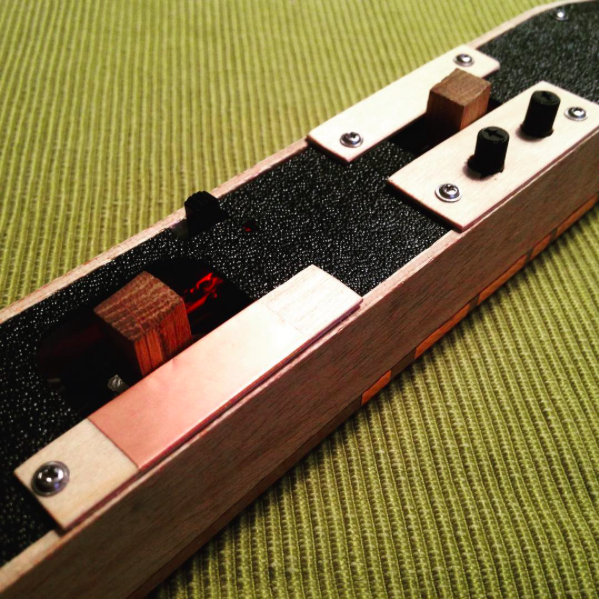In general, the playable prototype was a success! Fingers fell naturally on the touch pads with only three minor instances where the pads should be altered or moved. One was the bis key between LH1 and LH2, where the LH2 finger would go across the bottom corner of the bis pad. This was easily solved with an x-acto knife. Another problem was the LH pinky key being a bit to close to RH1. Slight risk for glitching there. To be solved in later versions. Not too big a problem at the moment. Then there was a minor issue with the RH pinky keys being a bit too close to each other. This was mainly caused by one of the pads being a tad too big. Also solved with the x-acto.
The choice of copper tape had an obvious backside to it – the oxidation. Using aluminium tape instead, or in combination with copper, could be a good alternative. I've also been looking at making metal inlays in the wood.
Playability with the breath was no problem, as that was already tuned well from the breadboard prototype. Pitch bend and modulation joystick was also very well placed and it felt natural to use. Pitch bend needed to be scaled down a bit though, so I added a pitch bend sensitivity parameter in the firmware. With the present setting it will go only 50% of the value for full pitch bend. Much better.
Octave shifting was not as easy to play as I had hoped. Using both X and Y of the joystick to control the octaves got kind of weird. I often slipped to the sides during play, and the sideways motion was generally not as intuitive as the up and down motion that on the other hand felt very similar to using the octave rollers on the "real" EWI. I decided to fix this by disabling the sideways motion and putting in a potentiometer for setting the base octave in five steps (-2 to +2) instead. This way I would get a wider range for the controller in total, but a more narrow range instantly accessable during play.
A feature I realized was missing was control for portamento (glide), and as there was an unused analog input on the Pro Mini and unused inputs on the MPR121 board I could easily add a potentiometer for portamento rate setting and a touch pad by the mod stick at the same time as I did the octave stick modifications. When adding these new features in the firmware I also changed the playing mode to legato when changing fingering while a note is already playing. That means the new note gets a MIDI note on before the old one gets a MIDI note off. This of course to make the portamento work. So far there have been no issues playing my wind controller patches with this change, but there might be instances where the legato mode could use a disable function. Might look into that later.

The firmware now feels pretty final, and the controller hardware is actually really nice to play! It is so light (200 grams) and small (300x40x35 mm for the main body) it feels more like playing a recorder than an EWI, and now when I switch to the EWI... well the EWI feels like an elephant in my hands :) I can without hesitation say: mission accomplished! :D
 Johan Berglund
Johan Berglund
Discussions
Become a Hackaday.io Member
Create an account to leave a comment. Already have an account? Log In.